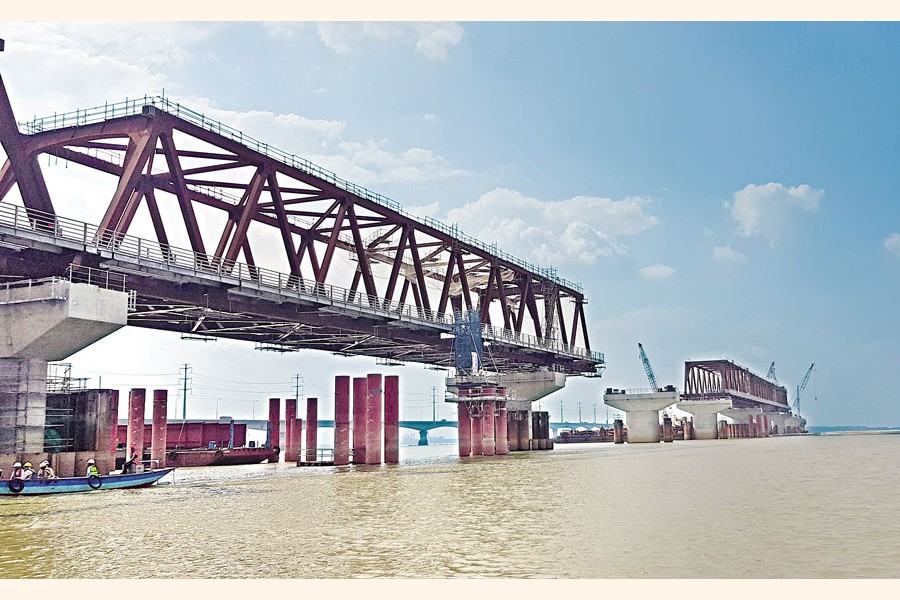MUNIMA SULTANA From Bangabandhu Sheikh Mujib Railway Bridge site | November 11, 2022 00:00:00
 The construction work of the Bangabandhu Sheikh Mujib Railway Bridge over the Jamuna River in Tangail is going on — FE photo
The construction work of the Bangabandhu Sheikh Mujib Railway Bridge over the Jamuna River in Tangail is going on — FE photo After the Padma road-cum-rail bridge, the dedicated railway bridge over Jamuna River is going to be another example of the country's unique bridge for adopting new technology.
Project officials said the 4.8-kilometre-long Bangabandhu Sheikh Mujib Railway Bridge (BSMRB) project has so far recorded 47 per cent progress since its commencement in August 2020.
It has adopted steel pipe sheet pile (SPSP) for foundation - for the first time in any railway bridge in the country.
Besides, the steel - used in the bridge's super structure - is rust-proof, and its colour will last for 100 years.
They also said the railway track of the bridge will be slipper-less, as trains will run on stringer at 100-120 km per hour speed.
BSMRB Project Director (PD) Al Fattah Md Masudur Rahman briefed a group of journalists at the bridge's eastern site office during a visit on Thursday.
The BSMRB project under the Bangladesh Railway (BR) arranged the visit to show the work progress as well as the span erection work at pier numbers 45 and 46.
The PD said so far six of its 50 piers have been completed, and steel truss spans from the eastern side have been set up.
The project's progress is lagging behind the target due to various reasons including the coronavirus pandemic. But, efforts have been taken to compensate the time loss.
The works under the two packages - WD-1 and WD-2 - for constructing the railway bridge have been accelerated during the last couple of months.
He also said SPSP foundation is a new technology to protect river erosion at piers. It has been used for the first time in any rail bridge and for the second time in bridge infrastructure in the country.
The Japanese contractor concerned first used the foundation technology in Kanchpur, Meghna and Gumti road bridges successfully.
Chief Contract Engineer of WD-1 Shirajul Islam Patwari said steel for the bridge spans is built in Japan and fabricated in Vietnam and Myanmar.
Besides, a local company - McDonald Steel - has recently got the fabrication work, which is being carried out at its Mirsharai plant.
The WD-1 engineer said the KMG steel - used in the three bridges - was steel narrow box girder, but that of the BSMRB is steel girder truss.
The Padma Bridge's span was erected on traveller crane method, which means setting up a ready span on two piers. But the Jamuna railway bridge uses cantilever erection method or crane barge method - by setting every component step by step from one span to another.
The Tk 167.80-billion project record shows that the work of WD-2 package is lagging behind than that of WD-1 although both of their work began simultaneously on August 10, 2020.
When asked about the reasons, BR Additional Director General (Infrastructure) Quamrul Ahsan told the FE that the contractor concerned took time to revise its plan due to finding different soil level from mobilisation stage to construction stage.
But the contractor later faced mechanical faults in the equipment that it brought from abroad for the construction problem, which also took some more time to get momentum.
The PD, however, said both manpower and equipment of the WD-2 have been strengthened and its S-curve has already shown improvement in month-to-month progress record.
Both the contractors are working to meet the target of completion by August 8, 2024 as per the contracts, he added.
The BR has taken the BSMRB project in 2016 after a feasibility study. The ECNEC approved its first development project proposal (DPP) on December 6, 2016 and the revised one on March 03, 2020 - fixing the completion schedule in August 2024 with another year for defect liability period.
The project work, funded by the Japan International Cooperation Agency (JICA), is being done by Obayashi-TOA-JFE joint venture of Japan for WD-1, and IHI-SMCC joint venture of Japan for WD-2 under the contracts signed on April 05, 2020.
Under the project, along with building a dual-gauge double-line 4.8-km railway bridge, a total of 30.73 km track will be developed on both sides of the bridge as viaducts, railway approach embankment, loops and siding.
Yard remodelling of stations on both sides of the bridge, signalling system and telecommunication upgradation at stations, railway museum, repair and reconstruction of river training work will also be carried out under another package - WD-3.
The embankment work on both sides of the bridge has also been started.
The PD said of the 49 spans, materials of 18 spans have reached at construction yard. Work of fabrication, trial, assembling and painting of the rest 31 spans are going on.
The WD-1 engineer said the trend of work that has been carried out at present shows that its progress will soon cross the target level.
© 2024 - All Rights with The Financial Express
